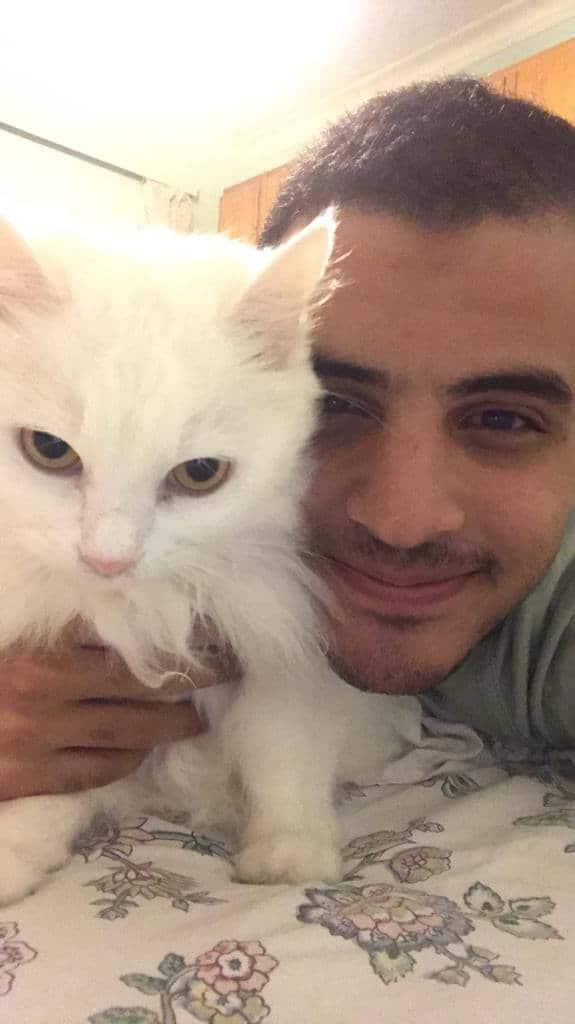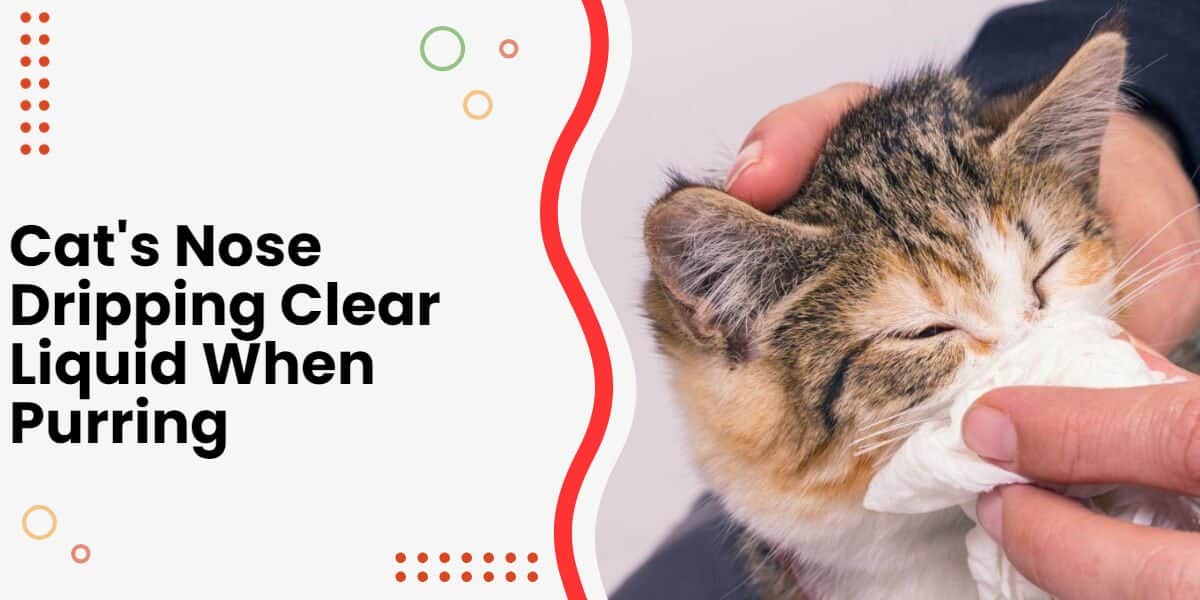Is your cat’s nose dripping clear liquid when they purr?
Don’t worry, this is a common occurrence and usually nothing to be concerned about. It could be a sign of contentment and happiness, or simply from grooming themselves more than usual. If your cat is otherwise healthy and playful, there’s no need to worry.
However, if the liquid’s colored or there are other symptoms, such as sneezing or coughing, it’s best to seek medical attention and check for underlying health problems.
In this quick guide, we’ll go into further detail about the possibilities behind your feline’s drippy nose and what you can do to fix it. So, stick around!
Table of Contents
Why Is My Cat’s Nose Dripping Clear Liquid When Purring?
If you’re not sure what’s causing your cat’s wet nose, it’s always best to take them to the vet for a diagnosis. Once the underlying cause is identified, the vet can recommend the best course of treatment.
That said, there are a few common reasons why your cat’s nose might be dripping clear liquid when purring, and these are:
1. Activated Sweat Glands
Cats have sweat glands located in certain hairless parts of their body, including the nose, paw pads, and lips.
These glands are activated when the cat needs to regulate its internal temperature. The purring can actually cause these glands to become active and because there’s no hair around to absorb it from the nose, you’ll notice dripping.
The amount of sweat produced by these glands is small too, so it’s not usually a cause for concern. However, if you notice a large amount of clear liquid dripping from your cat’s nose, it’s best to consult with your veterinarian beforehand.
Other factors that can activate sweat glands in cats include exercising, staying in a hot environment, and being stressed out or overweight.
Related: Why does my cat gag when purring?
2. Environmental Allergens or Irritants

If your cat has been exposed to any allergens or environmental irritants, it could easily cause their nasal cavity to drip.
Allergens come in many forms and will be unique to your cat. What affects one cat in the home, may not affect others in the same way.
While allergies aren’t a major health concern, it does cat owners a world of good to be aware of the most common culprits—and those are:
Pollen
Pollen is a common allergen for cats, and it can cause symptoms such as sneezing, coughing, stuffy nose, and watery eyes. Pollen allergies are typically seasonal, and they’re most common during the spring and fall when pollen levels are high.
Mold
Mold is another common allergen for cats, and it can cause similar symptoms to pollen allergies.
Be on the lookout for mold, both indoors and outdoors. It can grow in damp areas such as basements, bathrooms, and kitchens.
Dust Mites
Dust mites are tiny insects that live in dust and bedding. They’re a common allergen for people and cats, and they can cause symptoms such as sneezing, coughing, and itchy skin.
Dander
Dander is a type of skin flake that’s shed by cats and other animals. It’s a common allergen for people and cats, and it causes the typical allergy-induced symptoms.
Flea Saliva
Flea saliva is a common allergen for cats. It triggers a condition called flea allergy dermatitis (FAD). FAD is characterized by intense itching, which can lead to hair loss, skin lesions, and infection.
Other Allergens
There are many other potential allergens that can affect cats, such as:
- Smoke
- Perfume
- Cleaning products
- Certain fabrics
- Medications
- Food
3. Respiratory Infection
Cats of any age are susceptible to respiratory infections. These signs are quite similar to cold symptoms in people.
Viruses, bacteria, or fungi can cause respiratory infections in cats. Viral infections are the most common type, and they can be caused by a variety of viruses, including feline herpesvirus, feline calicivirus, and bordetella.
Any type of respiratory infection, however, can affect the upper respiratory tract (nose, throat, and sinuses) or the lower respiratory tract (lungs). Upper respiratory infections are more common, and they typically cause symptoms such as sneezing, coughing, wet nose, and watery eyes.
Bear in mind too, that respiratory diseases in cats are contagious, and they can spread from cat to cat through contact with saliva, nasal discharge, or tears—so postpone the cat play dates till your pet is better.

As for treating these infections, it’ll depend on the underlying cause. Viral infections can’t be cured, for instance, but you can deal with them through supportive care, such as fluids, antibiotics, and anti-inflammatory medications. Bacterial infections, on the other hand, can be treated with antibiotics.
To help reduce the risk of respiratory disease in the future, keep in mind the following:
- Vaccinate your cat against common respiratory viruses.
- Keep your cat’s environment clean and free of dust and allergens.
- Avoid exposing your cat to other sick cats.
Related: Why is my cat purring with its mouth open?
4. Eye Problems
In some cases, eye problems in cats can lead to a runny and sweaty nose. This is because the eyes and nose are connected, and inflammation or infection in one area can sometimes affect the other.
For example, if a cat has conjunctivitis, the inflammation can spread to the nasal passages and cause a drippy nose.
So, as a precaution, here are the most common eye problems that your feline might be susceptible to. Look out for the following:
Conjunctivitis
This is an inflammation of the conjunctiva, which is the clear membrane that lines the eyelids and covers the white part of the eye.
Conjunctivitis can be caused by bacteria, viruses, or allergies. Its symptoms may show as redness, swelling, discharge, and itching.
Corneal Ulcer
This eye problem causes a break in the cornea, which is the clear front part of the eye.
Trauma, infection, or allergies can cause corneal ulcers. Symptoms of illness include pain, redness, and discharge.
Glaucoma
Glaucoma increases the pressure inside the eye. It can damage the optic nerve and lead to blindness. It’s a serious condition that requires immediate medical attention.
Feline Herpesvirus
This is a virus that can cause conjunctivitis, keratitis, and other eye problems in cats. It’s also a contagious virus that can spread from cat to cat.
Feline Calicivirus
Feline Calicivirus is a virus that can cause conjunctivitis, upper respiratory infections, and other health problems in cats. It’s just as contagious too.
5. A Sign of Contentment
A wet cat nose is more often a good thing and isn’t a health concern. This is especially true if your pet is exhibiting other signs of contentment, such as relaxed body language and closed eyes.
If anything, purring is a natural feline behavior that’s often associated with happiness. When cats purr, they vibrate their vocal cords at a frequency of about 25 to 150 hertz.

This vibration has been shown to have a number of beneficial effects, including reducing stress, pain, and anxiety.
There are other tells that can indicate that a cat is happy and relaxed around you, such as slow blinking, head rubbing, and tail wagging.
How Can I Stop My Cat’s Nose from Dripping Clear Liquid When Purring?
For the most part, you’ll have to consult your trusted vet and let a professional decide how to deal with your cat’s drippy nose. That doesn’t mean you can’t offer your pet some relief in the meantime, though.
From experience, here’s the best way to deal with and possibly stop your pet’s nose from running:
- Find out why your cat’s nose is running. It could be allergies, a cold, or something else.
- Treat the underlying cause. If it’s allergies, keep your cat away from allergens. In case it’s a cold, your vet might prescribe antibiotics.
- Keep your cat’s nose clean and dry. You can wipe it with a damp cloth.
- Give your cat plenty of fluids. This should thin out the discharge.
- Use a humidifier or steam room as they help moisten the air and loosen the mucus.
Here are some preventative tips to stop your cat’s nose from running in the future:
- Keep your cat’s environment clean and free of allergens.
- Vaccinate your cat against common respiratory infections.
- Avoid exposing your cat to other sick cats.
If your cat’s runny nose doesn’t improve after a few days, or if they develop any other symptoms, such as fever or lethargy, take them to the vet right away.
Readers Also Check: Common reasons behind cat gulping while purring
Wrapping Up
A cat’s nose dripping clear liquid when purring can be caused by a number of things, including allergies, respiratory infections, eye problems, foreign bodies, and other medical conditions.
If you’re not sure what’s causing your cat’s runny nose, it’s always best to take them to the vet for a diagnosis. The vet can examine your cat and run tests to determine the underlying cause and treat it accordingly.
With proper care, most cats with a stuffy or wet nose can make a full recovery.

I’ve been living with cats since 2008 and I can confidently say I have more feline friends than humans lol. I currently live with 5 cats in different life stages; two of them are less than one year old, one is 2-ish years old and the oldest two are 9-ish years old. I’ve developed a strong bond with cats over the years and I’m eager to share my experience through this blog. You can learn more about my cats here.

